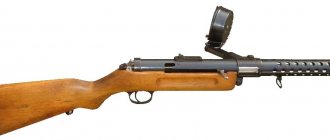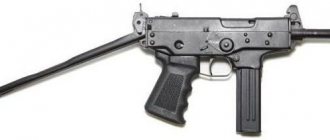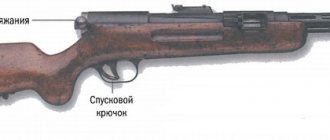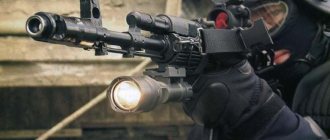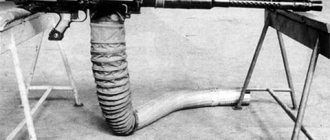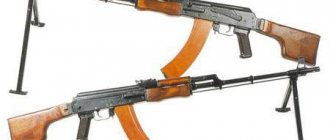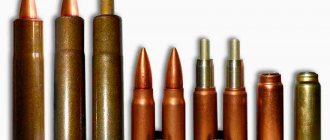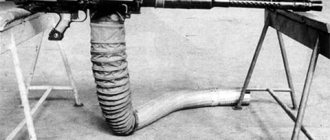Heckler und Koch UMP
This model has the following characteristics:
- caliber - 9 millimeters;
- rate of fire - up to 700 per minute;
- magazine capacity - up to 30 rounds;
- range - up to 100 meters.
The submachine gun, which appeared in the 1990s, is characterized by a relatively low price and the presence of a blowback bolt. This weapon is complemented by a double-sided safety and a slide delay, which is triggered after the magazine is empty of cartridges. This model supports 3 shooting modes: burst, single shots or 2-3 bullets at a time.
On top of the submachine gun there are mounts for installing additional accessories such as an optical sight and others.
"Kedr PP-91"/"Klin PP-9"
The submachine gun is characterized by the following features:
- caliber - 9 millimeters;
- rate of fire - up to 1200 rounds per minute;
- magazine - 20-30 rounds;
- Firing range - up to 100 meters.
The submachine gun appeared in the early 1990s and is used by Russian internal troops. The Klin PP-9 model is an improved version of the Kedr PP-91, designed for more powerful cartridges.
Both weapons have a similar design with blowback-based automatic action. These models provide a trigger mechanism. The submachine gun supports single-round firing modes. It is also possible to equip it with a silencer and an optical sight.
PPD
In the 30s of the twentieth century, the Degtyarev submachine gun (PPD-34) was created. The weapon was named after the Soviet designer V. Degtyarev. In 1934, the rifle model entered service with the Soviet army. The last modification was created in 1940. In the technical documentation it is listed as PPD-40. The Degtyarev submachine gun is the first Soviet serial automatic weapon. It was produced until 1942.
PPDs were widely used during the Soviet-Finnish War, and later during the Great Patriotic War. Then this rifle model was replaced by the Shpagin submachine gun, which, according to Soviet gunsmiths, was cheaper and more technologically advanced. The automation worked using the recoil energy of the free shutter. The barrel channel is equipped with four right-hand rifling. The PPD has a perforated casing, the purpose of which is to prevent mechanical damage to the automation, as well as protect the shooter’s hands from burns. In the first version of the PPD there was no fuse. It appeared in subsequent models. The fuse blocked the bolt and, as experts are convinced, was not reliable enough. There were especially many complaints about the fuses of worn-out PCBs. The submachine guns were equipped with sector-specific double-row magazines designed to hold 25 rounds of ammunition. During shooting, the magazine was used as a handle. In 1940, drum-type magazines were designed, the capacity of which was increased to 71 rounds. The functions of sighting devices were performed by front sights and sector sights. Since the submachine gun overheated greatly during operation, the soldiers were forced to fire in short bursts. Despite the fact that the weapon was theoretically suitable for targeted shooting up to 500 m, in reality it was possible to hit the target only from 300 m. According to experts, the pistol bullet retained excellent ballistics and destructive power up to 800 m.
IMI UZI/Mini UZI/Micro UZI
The line of Uzi submachine guns, known in Russia from American films, is distinguished by the following characteristics:
- caliber - 9 millimeters;
- rate of fire - from 600 to 1250 rounds per minute;
- magazine capacity - up to 32 rounds;
- Firing range - up to 100 meters.
This submachine gun was created using a blowback design, which made it possible to reduce the mass of the latter. A number of versions of the Uzi are complemented by a separate drummer with its own spring. To reduce recoil, the design of compact modifications includes a tungsten plate.
The fuse, located on the right side, is capable of completely or partially blocking the trigger. In the second case, shots are fired with single cartridges. Compact versions are complemented by silencers, and the IMI UZI can be combined with a rifle grenade barrel.
Submachine guns of the world
Home | Weapons | Submachine guns
This section contains detailed information about the history of creation, design, distinctive features, technical characteristics, advantages and disadvantages, as well as aspects of the practical use of submachine guns from around the world.
- Australia
- Austria
- Argentina
- Belgium
- Bulgaria
- Great Britain
- Hungary
- Germany
- Denmark
- Egypt
- Israel
- India
- Spain
- Italy
- China
- Poland
- Portugal
- Russia/USSR
- Romania
- Singapore
- USA
- Ukraine
- Finland
- France
- Croatia
- Czech
- Chile
- Switzerland
- Sweden
- South Africa
- Yugoslavia
- South Korea
- Japan
Submachine guns are automatic weapons that fire pistol cartridges. The small power of the cartridge used makes it possible to make the weapon relatively compact and lightweight, easy to handle, but limits the sighting range, as a rule, to 200 m. Submachine guns are usually fired in bursts, holding the weapon with both hands and pressing the butt to the shoulder. At the moment, submachine guns are practically not used in the armed forces; they have been replaced everywhere by assault rifles, but in some armies they remain in service with tank crews, signalmen, paratroopers and special forces units.
Submachine guns are mainly used by special forces troops, since due to the ability to fire pistol cartridges with a subsonic muzzle velocity, submachine guns can be used with silencers. The most famous military submachine gun created after the end of World War II is the Israeli Uzi. This submachine gun is available in various versions and is still popular today, thanks to the constant improvements made by the manufacturer to its design.
According to the State Standard No. 28653-90 currently in force in Russia, the term “submachine gun” is defined as “an assault rifle, the design of which provides for firing pistol cartridges,” while the term “automatic” is interpreted as an “automatic carbine,” which means a shortened weapon with rifled barrel, allowing burst firing. However, the term “automatic” is firmly entrenched in Russia for automatic weapons chambered for an intermediate cartridge, called an “assault rifle.” The term “submachine gun”, as a class of small arms, means “individual small arms automatic weapons chambered for a pistol cartridge, designed to be fired with both hands and/or resting on the shoulder,” since there are a number of pistols that have the ability to fire in bursts, such as APS and Glock 18. But in automatic pistols, burst fire is not the main firing mode, unlike submachine guns. However, in the West, compact machine guns chambered for an intermediate cartridge, for example AKS-74U or Colt M4, are sometimes classified as submachine guns (submachine guns in English), based on the tactical niche of these weapons and their dimensions, and not on the cartridge used, but this already an exception to the general rule.
The first submachine gun is the Italian Villar-Perosa M1915, created at the beginning of the First World War. This weapon is a double-barreled submachine gun that fires a burst of pistol cartridges. However, this model was more of a group support weapon than an individual infantry weapon. The first submachine gun in the modern interpretation of this term is the German Bergmann-Schmeisser MP.18 designed by Louis Schmeisser, created thanks to combat experience in trench warfare. Until World War II, the military of most countries greatly underestimated submachine guns as an army weapon for ordinary infantrymen. But research and development work in the field of creating effective models in the twenties and thirties was carried out in most industrial countries. Only the experience of the Spanish Civil War became a catalyst for work in this area. However, the USSR took submachine guns seriously only after the tragic combat experience and heavy losses in the Red Army personnel from the fire of Finnish Suomi submachine guns during the Winter War of 1940.
The development and use of submachine guns in the armed forces culminated in World War II. During this period, submachine guns such as the Soviet PPSh-41 and PPS-43, the German MP.40, the American Thompson, the English STEN and others were created and produced in the millions. But already in the middle of the war, a new type of small arms was developed, which subsequently replaced submachine guns in the armed forces. It was a machine gun, also known as an “assault rifle” (sturmgewehr - German, assault rifle - English). The machine guns had dimensions comparable to the PP, but had a significantly greater effective firing range and a flat bullet flight path. The USSR was the first to adopt assault rifles into service with the army - in 1949, the Kalashnikov assault rifle and the Simonov self-loading carbine chambered for the 7.62×39 intermediate cartridge were adopted.
A number of submachine guns with minimal dimensions can even be carried concealed. Such submachine guns appeared after the Second World War and began to gain popularity with the growing threat of terrorism, social unrest, interracial clashes of the 1960s-1970s, and consequently the increased need of law enforcement and security structures for compact and concealed, but at the same time effective weapons with high firepower. And here it is necessary to mention such a class of weapons as “personal self-defense weapons for military personnel” - Personal Defense Weapon / PDW in English-speaking countries. At first, such weapons included revolvers and self-loading pistols, then in 1940 the M1 self-loading carbine was created in the USA, which shot more accurately and further than a pistol, but was much more compact and lighter than a rifle. After World War II, submachine guns, or shortened machine guns and automatic carbines were used in the armed forces as personal self-defense weapons. By the 1970s, there was a need to develop a special small-caliber cartridge that would be close in recoil impulse and dimensions to a pistol cartridge, but at the same time, at short firing distances, would be comparable in ballistics to a small-caliber automatic (intermediate) cartridge.
Such a cartridge, in comparison with pistol cartridges, has an advantage in shooting accuracy due to the greater flatness of the flight trajectory of a pointed bullet and an advantage in efficiency in the penetrating action of the bullet against “anti-fragmentation” military vests. Compared to machine gun cartridges, it has less recoil and less weight, and in addition, it reduces the weight of portable ammunition. When working on this class of weapons since the 1950s. a number of prototypes were developed, such as the M1 carbine chambered for a special small-caliber .22 Johnson Spitfire cartridge, as well as those designed in the 1960-1970s. IMP Air Force survival pistol chambered for .221 Fireball and a gas operated automatic pistol chambered for Colt SCAMP special cartridge .22 SCAMP. But the adoption of “personal self-defense weapons for military personnel” took place only at the beginning of the 21st century. Moreover, this weapon began to be most widely used not for the tasks for which it was designed, but as a weapon for special forces and police. An example of this is the Belgian FN P90 submachine gun chambered for a specially designed small-caliber 5.7x28 cartridge. The HK MP7 A1 submachine gun chambered for a special small-caliber 4.6x30mm cartridge entered service with the German Armed Forces in 2006.
Currently, submachine guns are most widely used by the police and various anti-terrorism units, due to the compactness and flexibility in the use of these weapons. The most famous model used by police and special forces on both sides of the Atlantic is the German 9-mm Heckler und Koch MP5 submachine gun. There are many modifications of this weapon, differing in caliber, butt design, barrel length and dimensions, the presence or absence of a front holding handle, etc. The latest submachine guns are distinguished by an optimal combination of such characteristics as rate of fire, caliber, shooting accuracy, dimensions and weight, magazine capacity and modularity.
Submachine guns
- Austria
- India
- Hungary
- Czech
- France
- USA
- Singapore
- Spain
- Croatia
- Chile
- Bulgaria
- Russia/USSR
- Australia
- Finland
- Germany
- Switzerland
- Denmark
- Egypt
- South Korea
- South Africa
- Japan
- Israel
- Sweden
- Belgium
- Poland
- Ukraine
- Italy
- Romania
- Yugoslavia
- Argentina
- China
- Portugal
- Great Britain
Heckler und Koch MP-5
A German submachine gun, which is available in several modifications with the following characteristics:
- caliber - 9 or 10 millimeters;
- rate of fire - up to 800 rounds per minute;
- magazine - up to 30 rounds.
This model is characterized by increased reliability, proven during various military conflicts. Because of this, the German submachine gun has been adopted into service in many countries around the world, including the USA.
This weapon appeared in the 1960s and has been constantly improved since then. As part of each modification, the designers made changes to the length of the barrel and other design details. Therefore, all versions of German weapons are visually different from each other.
MAC-10
Officially, the best submachine guns 2021 cannot do without an American copy. Development started in 1964, but was completed only in 1966. The weapon entered service in the 1970s, and even saw action in Vietnam. Used in a number of different countries because it is considered one of the cheapest. Automatic mode is triggered by a free shutter. Indeed, when they created such the best pistols and machine guns in the world, they focused on cheapness and simplicity. At the same time, they did not think that in this way they were increasing recoil, and therefore reducing accuracy.
- Country: USA
- Caliber: 9 and 11.43 mm
- Rate of fire: 1100 high/min.
- Speed: 275 m/s
- Range: 25 m
- Weapon length: 269 mm
- Weight: 2.84 kg.
Steyr AUG Para 9mm
Steyr products are distinguished by the following characteristics:
- caliber - 9 millimeters;
- rate of fire - up to 700 rounds per minute;
- magazine capacity - up to 25 rounds;
- range - up to 250 meters.
This model appeared as a result of reworking a machine gun, which was combined with an assault rifle, under a caliber of 9 millimeters. Such changes made it possible to create a submachine gun that is more effective in close combat. Therefore, Steyr’s customers for these products were internal services of different states, including special forces.
If necessary, the AUG Para can be converted back into a rifle. Moreover, such an operation is carried out in the field by the shooter. To do this, you need to replace the bolt group, barrel and some other components. For such alterations, machines of the same brand are used. The AUG Para is complemented by a blowback action. Fire can be carried out either with single cartridges or in bursts.
KRISS Vector
There are many cool weapons in the United States of America, one of the fresh ones is the KRISS Vector, which is included in the most powerful submachine guns 2022 and fresh. It was developed in 2006, and put into production in 2009. At the time of release, it was planned to create a weapon that would have crazy accuracy. Additionally, we tried to make the dimensions more compact. The specimen was mainly created for the .45 ACP caliber, but the 9mm Parabellum can also be used.
- Country: USA
- Caliber: 9, .45, .40, .357 mm
- Rate of fire: 1500 high/min.
- Speed: 400 m/s
- Range: 45 m
- Weapon length: 617 mm
- Weight: 2.5 kg.
ST Kinetics CPW – Compact Personal Weapon
ST Kinetics CPW is characterized by the following features:
- caliber - 9 millimeters;
- rate of fire - up to 1300 rounds per minute;
- magazine capacity - up to 30 rounds;
- Firing range - up to 100 meters.
The Singapore company's submachine gun appeared in 2008. The model was created as a replacement for police weapons used for self-defense. The design of this development is characterized by its ability to be modified: if necessary, the shooter can increase the caliber by installing the appropriate barrel.
ST Kinetucs SPW is characterized by its compact size and weight, convenient for constant carrying. The advantages of this weapon include an increased rate of fire. This development implements automatic action with a semi-blowback, supplemented by lever braking. There are 2 modes for firing: single cartridges or burst. The controls are located on both sides, making the weapon easier to use.
HK MP5
Developed under the leadership of Thilo Müller, Guhring, Seidl and Baureter, the best submachine gun in this country to date. It was received in 1964 and a couple of years later, in 1966, it began to be used. The sufficient length of the barrel reaches 22.5 cm, so the energy transfer is maximum, which allows the bullet to accelerate so much that its energy reaches 650 joules. Also, many people fell in love with this weapon due to its low recoil and high accuracy, despite the rate of fire. One of the top submachine guns has a robust design and is very easy to disassemble. Over the entire period of its existence, at least 6 modifications were invented.
- Country: Germany
- Caliber: 9 mm
- Rate of fire: 800 high/min.
- Speed: 400 m/s
- Range: 200 m
- Weapon length: 680 mm
- Weight: 2.54 kg.
TDI Kriss Super V
American development is characterized by the following features:
- caliber - 0.45;
- rate of fire - up to 1100 rounds per minute;
- magazine capacity - 30 rounds;
- firing range - 125 meters.
The American development stands out from its analogues by using a special system (the recoil impulse is directed downwards), which reduces recoil and increases the accuracy of fire.
This is also facilitated by the design solutions implemented in the TDI Kriss Super V.
FN P90
FN P90 is characterized by the following properties:
- caliber - 5.7 millimeters;
- rate of fire - up to 900 rounds per minute;
- magazine capacity - up to 50 rounds;
- Firing range - up to 200 meters.
The FN P90 is complemented by a red dot sight with adjustable illumination. This model is built according to the open shutter design. The Belgian-developed design provides mounts for a laser sight and other devices.
PP-2000
The Tula development is characterized by the following properties:
- caliber - 9 millimeters;
- rate of fire - up to 600 rounds per minute;
- magazine - up to 30 rounds;
- Firing range - up to 150 meters.
The PP-2000 is complemented by a collimator sight and a folding stock. This development is created according to the open-gate design. The handle of the PP-2000 is covered with plastic, which allows you to hold the submachine gun with both hands. This weapon is capable of firing single rounds or bursts.
Introduction to weapons
According to experts, such a definition as a submachine gun (SMG) is not entirely suitable for designating a small arms unit. It will be easy for an inexperienced person to get confused. It may seem that this weapon combines the characteristics of pistols and machine guns. In fact, PP is an independent type of small arms. A submachine gun is more of an assault rifle, which is structurally adapted for firing pistol ammunition. Thus, the SMG is considered an automatic weapon capable of continuous firing. Due to their large mass and dimensions, submachine guns cannot be considered automatic pistols. Since SMGs use low-power pistol cartridges, these shooting units cannot be machine guns or assault rifles.
Heckler–Koch HK MP7A1 PDW
This submachine gun is considered the best on the world market. This development has the following characteristics:
- caliber - 4.6 millimeters;
- rate of fire - up to 950 rounds per minute;
- magazine - up to 40 rounds;
- Firing range - up to 200 meters.
A cartridge was specially developed for this model, which has good penetrating ability. In terms of characteristics (ease of holding and wearing, automation circuitry, etc.), German products are comparable to PP-2000.


